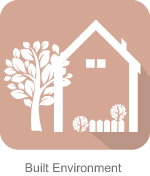These recommendations reflect actions and outcomes identified in the STAR process as well as recommendations stemming from the related data collection and modeling efforts. Where appropriate, the recommendations also reflect linkages with the county’s Monroe County Climate Action Plan (MCAP). For detail, please click here.
 Government Operations
Government OperationsRecommendations for the Government Operations focus area increase the sustainability and resilience of Monroe County operations, from energy and water conservation to green product purchasing and waste reduction. They also cover renovating and upgrading facilities and infrastructure.
The team identified eight goals to address these vulnerabilities. For these eight goals, the project participants identified 57 recommendations for the county. For detail, please click here.
 Climate & Energy
Climate & EnergyFive goals were identified for this focus area. For detail, please click here.
The GreenKeys! process created 19 recommendations to continue the county’s commitment to reducing climate change impacts and increasing resource efficiency for a more sustainable, resilient community.
 Natural Systems
Natural SystemsNatural systems are critical for both the tourism economy and future resilience of Monroe County. However, numerous scientific studies have noted that Monroe County’s marine and terrestrial habitats are among the most vulnerable to climate change impacts in the United States.
Perhaps the most predictable of these projected impacts is long-term disappearance of upland
ecosystems and associated species that become inundated by rising seas. There is also significant potential for large-scale changes in the composition and productivity of marine ecosystems due to the combined stressors of ocean acidification (associated with increased carbon dioxide in the atmosphere), increased ocean temperatures, and rapid sea level rise.
Impacts of climate change on intertidal mangrove wetland communities are among the least predictable. Such communities could potentially decline or expand, depending on multiple factors that include rate of sea level rise, changes in regional sedimentation patterns, and the extent of human engineering in the intertidal zone
Despite these risks, resilience to storms, flooding, erosion, and other threats can be strengthened when coastal communities are protected by natural infrastructure including marshes, reefs, and beaches. Resilience of coastal communities is also strengthened with hybrid approaches like “living shorelines,” which combine natural habitat and built infrastructure. Hybrid approaches often provide more cost-effective flood risk reduction options and alternatives for communities, especially when limited space precludes the use of natural coastal protection alone.
Five goals were identified for this focus area. For detail, please click here.
To meet these goals, the Greenkeys! process developed 21 recommendations. For detail, please click here.
 Built Environment
Built EnvironmentThe built environment includes roads, buildings, and power supply structures.
As sea level rise increases, it will be increasingly risky to develop in low-elevation land areas where tidal flooding is common and storm surges are severe.
Existing building codes and flood insurance requirements will not eliminate this risk. Policies and land development regulations will need to be periodically updated to ensure that coming risks are accounted for. Individuals and business owners need information to make decisions for their specific circumstances
There are four main strategies for adapting to sea level rise and increased storm surges:
Avoid—limit development in particularly vulnerable areas, redirecting development to less vulnerable areas.
Protect— use hard or soft structures to protect structures and prevent flood waters from reaching community assets. Hard structures could include seawalls or bulkheads, while soft structures could include geotextiles tubes and giant fabric sandbags designed to be replaced after storms. Accommodate—acknowledge long-term effects but implement short-term actions to make structures more resilient, such as elevating structures or their critical systems.
Retreat—relocate existing structures, people, and land uses away from high-risk flood areas. It allows
Five goals were identified for this focus area. For detail, please click here.
To meet these goals, the GreenKeys! process developed 24 recommendations. They address vulnerabilities of the built environment, further reduce noise and light pollution, and improve alternative modes of transportation . For detail, please click here.
 Health & Safety
Health & SafetySustainable communities require healthy populations and resilient systems. Resilience includes not only climate change resilience, but also disaster preparation and management.
The Local Mitigation Strategy (LMS) for Monroe County and its municipalities a critical resource for improving resilience to natural hazards. The LMS estimates the damage and disruption that could result from a hurricane or other disaster. It then determines the best strategies for reducing exposure of people and property. LMS projects are eligible for certain state and federal grants.
Significant health problems are associated with climate change impacts, especially these:
Five goals were identified for this focus area. For detail, please click here.
For meeting these goals, the GreenKeys process developed 22 recommendations to prevent disease, injury, and premature death. For detail, please click here.
 Education, Arts & Community; Economy & Jobs; and Equity & Empowerment
Education, Arts & Community; Economy & Jobs; and Equity & EmpowermentThe Education, Arts, & Community portion of this focus area promotes an educated, cohesive, and socially connected community. Monroe County established the Art In Public Places Committee to place art in public places. It administers the purchase and installation of artwork under a 1% for art program paid for by major new county construction or renovation projects. The Florida Keys Council of the Arts serves as staff to this committee and is the main source of information on arts and culture in the Florida Keys.
The Economy & Jobs portion of this focus area promotes equitably shared prosperity and access to quality jobs. Tourism is the largest industry in the Florida Keys and a major factor in the Monroe County economy. It accounts for roughly 60% of the local economy, 44% of the local income, and nearly 55% of the workforce.in the County.
The Equity & Empowerment portion of this focus area promotes promote equity, inclusion, and access to opportunity for all residents. Equity and empowerment are critical components of sustainability. Environmental degradation intensifies inequality in human development and vice versa.
Environmental sustainability is most easily achieved by addressing health, education, income, and gender disparities together with energy production and environmental protection. Fairer flows of public investment; more democratic, inclusive and accountable institutions; coordinated implementation and monitoring systems; and climate resilient strategies— all of these contribute to achieving equitable and sustainable development.
Three goals were identified for this focus area. To meet these goals, the GreenKeys! process created 20 recommendations for the county. For detail, please click here.